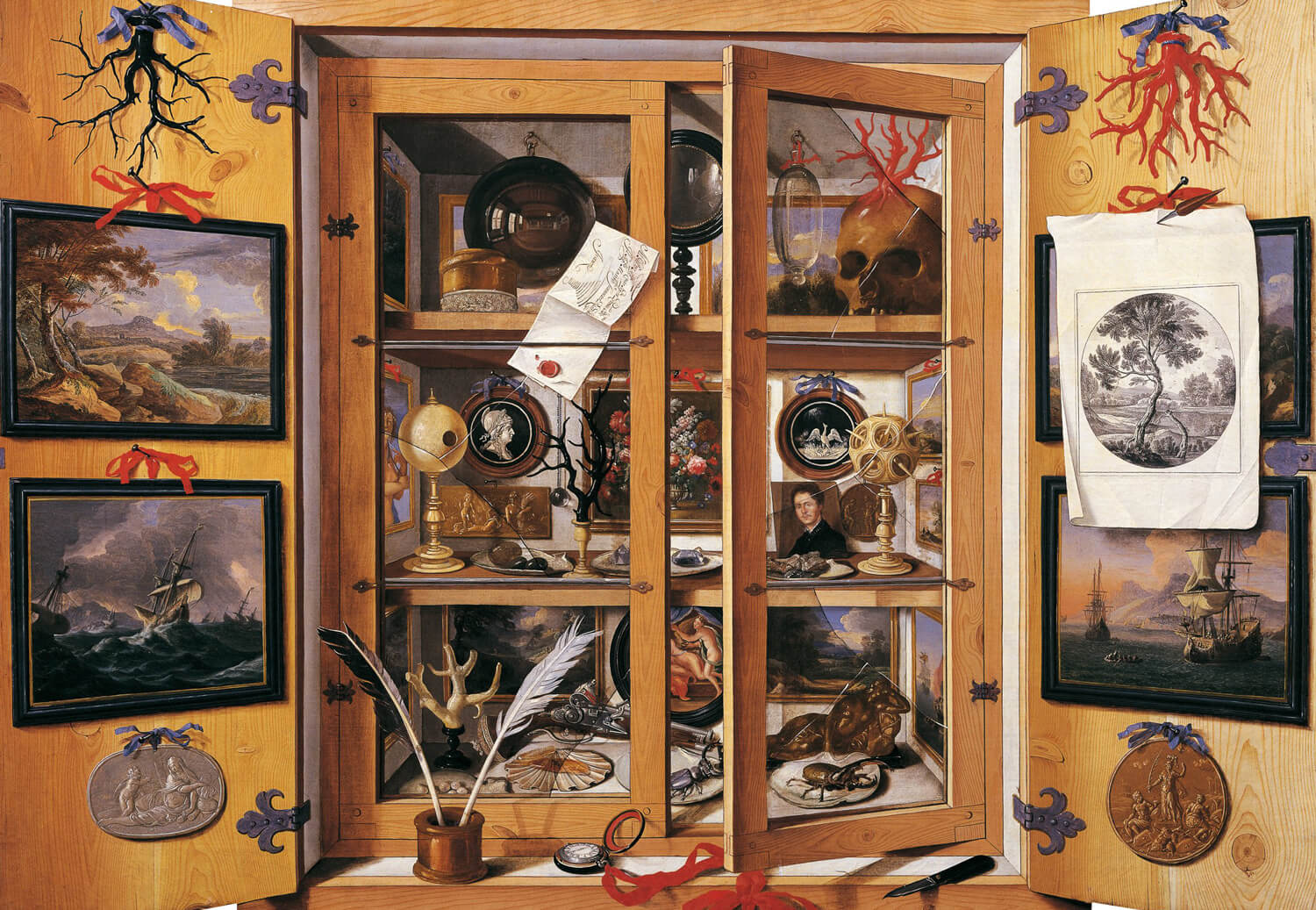Theme leaders: Dr Dan Lockton, d.j.g.lockton@tue.nl and Femke Coops, f.coops@tue.nl
When a loved-one dies, we need time and space to grieve and let go, while the everyday carries us along and urges us to pick up the threads, reshape life, build new relationships, and explore new avenues. But when our world collapses due to societal challenges, and we have to say farewell to practices, structures, and—in the end—certain ways of living, there hardly seems to be any consideration for grieving or letting go. Can we really embrace new futures regarding sustainability transitions, a small greener footprint, reduced consumption, etc., without any room for a process of mourning and releasing?
Coops et al (2024)
Image: A cabinet of curiosities c.1689 painted by Domenico Remps (Wikimedia Commons)
There’ll be a last time that you ever use the electronic device you’re reading these words on. Do you notice when you stop doing things in a certain way, or stop using an object entirely? If you look back a few years, what everyday things did you do in a different way? What changed? What can you imagine changing in the years ahead? How does this make you feel? How do others feel?
In this project, we are asking you on the one hand to imagine being in 2050. You are 26 years older than you are now. The world is very different to now in some ways, and similar in others (you can use some of the tools and methods introduced in the course to speculate/extrapolate to create these scenarios). There is climate change, with huge social, cultural, economic, and political effects, and technological change too. In 2050, some of the objects and everyday practices that are common in 2024 have disappeared from our lives, or transformed. That process has not necessarily been easy or uncontroversial. But it has happened, with practical and emotional consequences, and it is something that designers have contributed to.
Imagine visiting a museum in 2050 and encountering a cabinet of rarities—a kind of wunderkammer which features objects (or practices) that don’t have a place in the future any more. It could be focused on a particular aspect of life (food, transport, clothes, etc) or a broader angle or perspective across many areas of life (e.g. entertainment, or education), or something more personal entirely. The cabinet includes both objects (or things that represent the practices around those objects—e.g. car keys) and annotations explaining or giving an insight into the stories of how they went away, or transformed, and what the emotional aspects of that process were like. Did people grieve for them? Did people celebrate? Did people just not notice their passing?
We want you to design and create (the contents of) such a cabinet of rarities for 2050. It could take a variety of forms (see below) and you could make use of your own experiences, blended with (informed) speculation and fabulation (fiction).
But before this, the first part of this project, where you are ‘back in the present’ (or the near future), is about the process by which such a cabinet is designed and created. How would you, in the near future, go about phasing out (or imagining/planning how you would) or transforming aspects of how you do something in everyday life? How would different people around you (friends or family, perhaps from different generations) experience this? We want you to design a process or guide for people to arrive at being able to create their own cabinet of rarities—how to decide what to include (based on the criteria for the future scenario/s you imagine), how to support people ‘letting go’, how to record their feelings and priorities, and how to present and share the objects. Could this be a new form of service design, an experience that helps people come to terms with changing how they live? Is it a DIY tutorial video? A collective nostalgia (or solastalgia? (Albrecht et al, 2007)) ritual? It’s up to you.
Background: Designing away
Movements such as Marie Kondo’s KonMari method, Swedish Death Cleaning, and various approaches to minimalism in living have mainly focused on decluttering, and mainly in rather privileged contexts, but there are also other ways in which people ‘let go’ of certain objects or practices—or even the idea of them. You may have become vegetarian or vegan, or turned your phone to greyscale to reduce addiction, or, having grown up imagining yourself owning a car, not done so. Nevertheless, this kind of change or transition is not always easy. There are practical, systemic challenges, but also emotional and personal ones: it can spark joy but also grief. As Coops et al (2024) put it, “we tend to underestimate that we do not only develop attachment bonds with living beings surrounding us, but we also develop relationships, attachments, as so- called material possession or material culture, with the established practices and—in the end—physical environments and systems we live in and with… When letting go of certain objects, practices, or places, we might experience this as losing a part of ourselves”.
While some studies of the KonMari method (e.g. Chamberlin & Callmer, 2021) suggest that it can have wider effects in changing people’s consumption behaviour, many design researchers have argued that much more systemic-level changes are needed. Design itself needs to play an active role; Tonkinwise (2014) argues that “not-designing is also a kind of designing; it can be proactive, a deliberate strategy to undesign, to make existing designs disappear. The opposite of the vita activa of making, of designing things into existence, is not merely the privatively passive vita contemplativa, but rather the very active act of unmaking aspects of our locked-in world; the designing of things out of existence.” You might ask yourself: will this spark joy for future generations?
Or, it could be that this process also shows us more clearly which existing design in fact does not need to go away, because it is well-suited to the futures ahead—as Fry (2005) noted, “constructive acts of ‘clearing’, allow[…] us to identify what really matters to us so we may be sustained spiritually, symbolically, intellectually as well as physically” but also so that “‘already existing sustainable design’ can reveal itself. What is being identified here is the plethora of often common and overlooked made objects and built forms that have historically demonstrated an ability, in the right hands, to sustain.” Perhaps some objects can be adapted, repurposed for new needs in a different future.
Finally, quoting again from Coops et al (2024), in design and transitions research we rarely think about letting go—we rarely “see it as a way, and necessary step, to make space for and shape the new. Letting go and saying goodbye is, however, necessary to make space for imagining and building up (radical) new practices, structures, and cultures”.
The specifics
- Your task is to design and create:
- The contents of a cabinet of rarities for 2050 focused on objects (or practices) that don’t have a place in the future any more. The objects should be annotated, explaining or giving an insight into the stories of how they went away, or transformed, and what the emotional aspects of that process were like. The physical ‘cabinet’ itself can be something that you make if you have a specific design in mind, or you can use an existing display case / something else. We can help with this.
- A guide or process for people to arrive at being able to create their own cabinet of rarities. This could be based on your own process (so you essentially ‘try it out’ in an autoethnographic way). The guide should be shareable online (e.g. a PDF, video, webpage, etc)
- You choose the scenario for 2050 (based on research and extrapolation) and area/s of everyday life you focus on
- The experience of the cabinet of rarities + the guide for people to create their own is intended to be something that visitors to the Researching the Future Everyday exhibition on 11 June 2024 can take part in. You can plan this as an exhibit that people visit in their own way, a ritual, a kind of timeslip into the future, a curated experience with a particular time slot, an activity, or a performance. You can choose to invite specific people to visit, if there’s an audience who would be most relevant for you
- As a group, you will also create a short “catalogue” article about your project (online and print), along with a full research article.
- Individually, you will do a blog post during the project exploring your approach, and a short reflection at the end, focusing on how you think about the future as a designer
- See the syllabus for full details of the assignments
Some examples that might be inspirational
- Carbon Ruins by the Climaginaries project (see also Stripple et al, 2021 below)
- The Museum of the Linear Economy from the Urban Futures Studio, Utrecht University
- Julia Cambre’s ‘Morbid Methods’ for products—obituaries, eulogies, and postmortems
- Cassie Robinson’s talk ‘Emerging Futures: Patterning the Third Horizon’ from The Conference Malmö, 2023
Things to read
All these articles are available on Teams in the ‘Files’ tab.
- Femke Coops, Kristina Bogner, & Caroline Hummels (2024). Letting go in sustainability transitions: designing spaces for the unavoidable companion of change. In Routledge Handbook of Sustainable Design (pp. 493-504). Routledge. https://doi.org/10.4324/9781003365433
- Johannes Stripple, Alexandra Nikoleris, & Roger Hildingsson (2021). Carbon Ruins: Engaging with Post-Fossil Transitions through Participatory World-Building. Politics and Governance 9(2), https://doi.org/10.17645/pag.v9i2.3816
- Corina Sas & Alina Coman (2016). Designing personal grief rituals: An analysis of symbolic objects and actions. Death Studies, 40(9), 558-569. https://doi.org/10.1080/07481187.2016.1188868
- Erika Summers‐Effler (2002). The micro potential for social change: Emotion, consciousness, and social movement formation. Sociological Theory, 20(1), 41-60. https://doi.org/10.1111/1467-9558.00150
- Tony Fry (2005). Elimination by design. Design Philosophy Papers, 3(2), 145-47. https://doi.org/10.2752/144871305X13966254124554
- Cameron Tonkinwise. (2014). Design away. Design as Future-Making, Barbara Adams and Susan Yelavich (eds.). Bloomsbury Academic, London and New York, 198-213.
- Lucy Chamberlin & Åsa Callmer (2021). Spark Joy and Slow Consumption: An Empirical Study of the Impact of the KonMari Method on Acquisition and Wellbeing. Journal of Sustainability Research. 2021;3(1):e210007. https://doi.org/10.20900/jsr20210007.
- Glenn Albrecht, Gina-Maree Sartore, Linda Connor, Nick Higginbotham, Sonia Freeman, Brian Kelly, Helen Stain, Anne Tonna, & Georgia Pollard (2007). Solastalgia: the distress caused by environmental change. Australasian Psychiatry 15, s95–s98. https://doi.org/10.1080/10398560701701288


